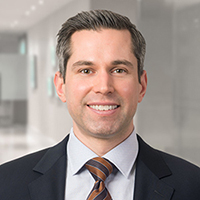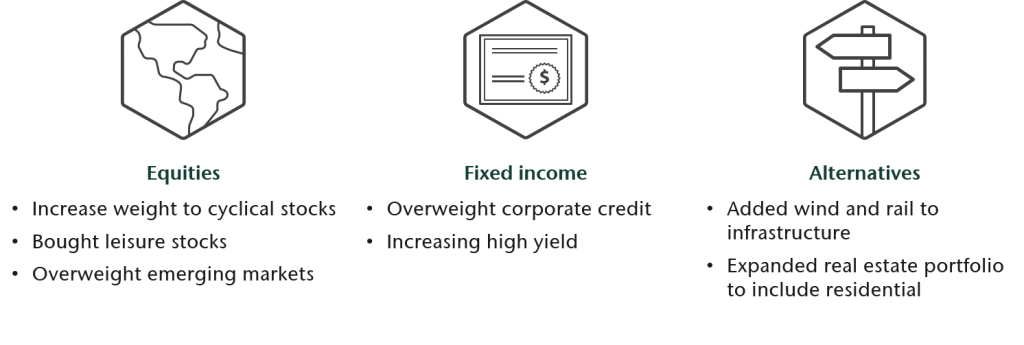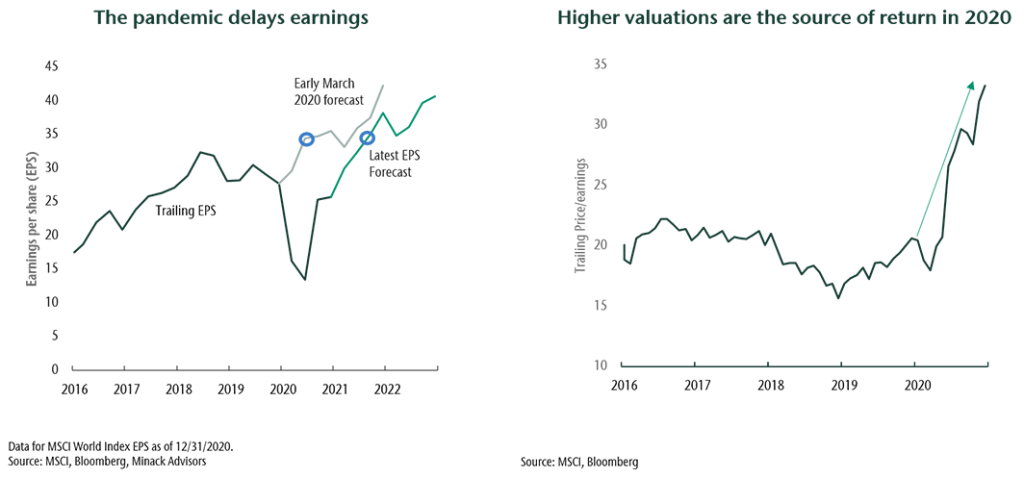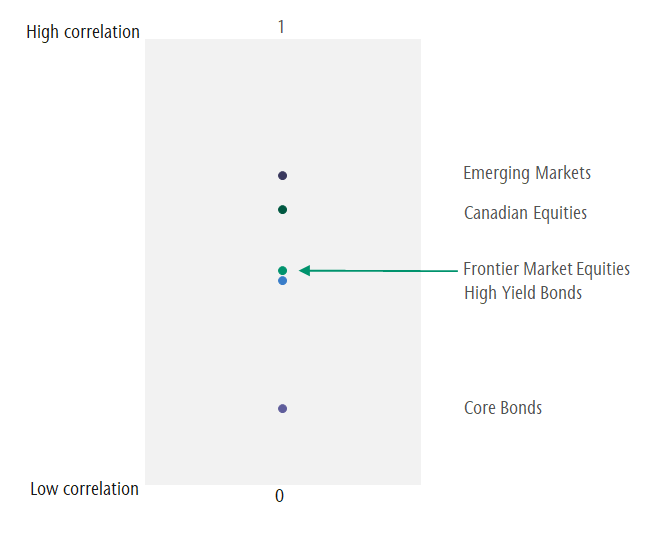
The start of 2023 was marked by caution, largely influenced by the prior year’s market environment that witnessed several firsts. 2022 was the first time investors faced double-digit negative returns from both equity and traditional fixed income investments in a calendar year. Many defined benefit (DB) pension plans also experienced a rapid change in their financial health, moving from deficits to meaningful surpluses despite the challenging markets. Returns in 2023 have bounced back strongly, though not without many twists and turns. This article reflects on 2023 and offers insights for the year ahead.
Interest rate surprise
The rapid rise in interest rates surprised many investors and the impact varied among investor types. Investors with a total-return goal, such as endowments, foundations and Indigenous trusts, saw portfolio market values drop in 2022 due to negative returns in both equities and fixed income. In contrast, despite negative asset returns, many DB pension plans saw their deficits replaced by surpluses as the decrease in liabilities outpaced asset declines.
Higher yields implied more favourable longer-term returns for fixed income, and discussions in 2023 shifted from the past focus of reducing fixed income allocations towards assessing the merits of increasing allocations for all investor types.
Balancing act
For total return-oriented entities like endowments, foundations and Indigenous trusts, an improved fixed income outlook was welcome. However, historical data suggests that higher fixed income yields can indicate lower equity market returns (see “crystal ball challenge” below).
Registered charities are dealing with the added impact of an increase in the minimum annual distribution quota (DQ) requirement from 3.5% to 5.0% introduced in 2023. This change could lead charities to target higher returns or accept a lower margin of additional return to meet the higher DQ.
The prospect of higher fixed income returns and potentially lower equity returns provided an opportunity for investors to reassess their asset mix strategy to ensure alignment with their goals, particularly if their fixed income allocation has been historically low or well below target allocations.
Opportunity knocks
The start of 2023 brought significant improvement to the financial well-being of many DB plans, after decades of additional contributions to counteract the adverse effects of declining interest rates and subsequent stronger growth of the liabilities compared to the asset growth. The better financial position provided an opportunity to revisit long-term asset mix strategies and risk levels.
The specific actions of DB plans depend on the plan type (e.g., corporate, university or public), actuarial liability measures that drive risk assessments, and other factors such as whether the DB plan is open or closed to new members, and plan maturity (e.g., percentage of active members versus retiree and deferred members). At a minimum, for plans that found themselves in a healthier funded position, there was a strong case for discussing the merits and trade-offs of de-risking.
While it’s unclear to what extent DB plans took the opportunity to de-risk and shift towards higher fixed income allocations, there was an uptick in fixed income search activity in the latter part of 2023, possibly indicating a trend by committees towards reassessing their asset mix strategy. However, the market roller coaster ride in 2023 was evident in both fixed income and equities. Longer-term bond yields experienced further increases at the end of the third quarter and into the start of the fourth quarter, but then yields subsequently declined leading to longer-dated fixed income investments bouncing back very strongly and achieving returns higher than major equity markets. The higher fixed income returns are likely a reflection that liabilities over the fourth quarter increased more than the assets and reduced some of the previous improvement in DB plans’ funded position.
One form of risk management that has continued unabated is de-risking through annuity purchases, especially in corporate DB plans, where the transaction can reduce the impact of DB plans on a company’s balance sheets. Many companies that chose the annuity purchase route for de-risking did so when inflation was low. Depending on the extent of built-in inflation-related pension increases, these companies might face pressure from retirees for ad-hoc pension increases given the higher inflation environment. Under a buy-out annuity, the structure is such that post-transaction there’s no longer a dedicated pool of assets with the plan sponsor for members captured under the buy-out, implying the only source of funding for ad-hoc increases would be the company’s balance sheet.
Tech titans increase market concentration
In 2023, equity returns were dominated by U.S. mega-cap stocks, particularly in the information technology sector, which benefited from investor exuberance around artificial intelligence (AI) and added to the concentration challenges of the bellwether S&P 500 Index. As shown in Figure 1, the S&P 500 Index’s top-10 holdings represented almost a third of the Index at the end of 2023.
Figure 1: Weight of top-10 holdings in the S&P 500 Index
Source: Connor, Clark & Lunn Financial Group and S&P Global Market Intelligence.
U.S. equities typically represent the largest individual component of many investors’ portfolios. Upcoming committee meetings should include discussions on the increasing concentration in the U.S. equity market. This isn’t to say the U.S. technology sector won’t continue to perform well over the next decade. However, it’s prudent to consider the benefits of diversifying the portfolio and to evaluate options for managing potential downside risks should negative outcomes unfold.
While diversification within equity markets is one option, such as leveraging the lower correlation merits of emerging markets compared to developed markets or pairing a value investment style with a growth portfolio, diversifying through fixed income and private market investments may be more advantageous. Therefore, any diversification strategy should include a broad set of investment opportunities and extend beyond equities.
Mixed experience from private markets
Over the past 10 years or so, private markets have experienced significant inflows from institutional investors. In 2023, the returns across various private markets have been mixed. Commercial real estate made most of the headlines for two reasons. First, there was the lingering impact from the COVID-19 pandemic on the office sector, leading to decreased market valuations. Secondly, some commercial real estate managers had liquidity issues, delaying divestiture requests. Other real estate sectors performed well, helping to offset office sector declines in diversified portfolios and contributing to a more optimistic market outlook for 2024 and longer term.
Private equity markets were also challenged in 2022/2023, but the forecast for 2024 and beyond is much more positive. In contrast, the infrastructure market was a standout performer in 2023 and appears well-positioned for the future. Infrastructure is increasingly seen as crucial for supporting clean energy projects and reducing reliance on carbon-intensive assets as part of global efforts to address climate risk. A successful energy transition will require extensive new infrastructure globally, focused on renewable energy sources.
The crystal ball challenge
Forecasting returns is no easy task. For example, a Horizon Actuarial Services survey of U.S. investment managers and consultants found that they significantly underestimated the strength of the U.S. equity market for the 10-year period ending December 31, 2022, and overestimated the weaker returns of emerging markets. The average annualized U.S. equity return projection was 5.9%, compared to the actual return of 12.6%. Emerging market equities were expected to return 7.5% but delivered just 1.8% (all returns in U.S. dollars).
There is, however, a historical correlation between yield levels and the outlook for equity market returns. Figure 2 illustrates the distribution of 10-year historical returns for the S&P 500. The green bars represent periods where U.S. government 10-year bond yields at the start of the 10-year period were below 3.5%, while the gold bars show returns when starting yields were between 3.5% to 5%. For example, when the yields were below 3.5%, around 20% of returns were around 17.5%. The overall average annualized S&P 500 return when yields were below 3.5% was 10.8%. Conversely, when yields were higher, such as the end of 2023, the average annualized Index return was 6.7%.
Figure 2: U.S. equity returns depending on the level of fixed income yields
Source: Connor, Clark & Lunn Financial Group.
Despite the recent decline in yields, longer-term return expectations for fixed income remain higher than what we’ve seen in a while. The level of yield at the time of writing also indicates the potential for lower long-term equity returns compared to previous strong performance.
For private markets, it is difficult to generalize since the outlook is heavily influenced by the specific strategy in which you’re invested. It’s therefore important to engage with your private market managers to understand their return expectations and assess the risk of liquidity constraints, like those recently seen in some commercial real estate strategies.
In other private markets, such as private debt, the current environment has likely enhanced its relative return potential, possibly attracting increased interest from all investor types. As noted earlier, the emphasis on energy transition to address climate risk will likely boost interest in specialized energy infrastructure strategies. Present conditions also provide an opportunity to consider more liquid, higher-yielding assets, such as commercial mortgages, that can take advantage of current higher rates.
2024: Steering through uncertainty
As your committee reviews 2023 performance, there should be welcome relief from strong positive total portfolio returns. For DB plans considering a de-risking strategy, the fourth quarter was a reminder that the opportunity to take advantage of a healthier financial position was not timeless and that there are scenarios where lower yields (and subsequent increases in liabilities) could prevail.
The top-performing market in 2023 was the U.S. equity large-cap market that was a beneficiary from the enthusiasm around AI. While the positive impact of technological innovation may persist, it’s up against a challenging economic, social and political backdrop, along with associated uncertainties. Geopolitical risks, including the U.S. election, conflicts in the Middle East and Europe, and the U.S.-China rivalry could significantly affect shorter-term market outlooks in 2024.
Given the various dynamics highlighted, ensure that committee meeting discussions focus on confirming whether your risk-return profile aligns with your objectives.








